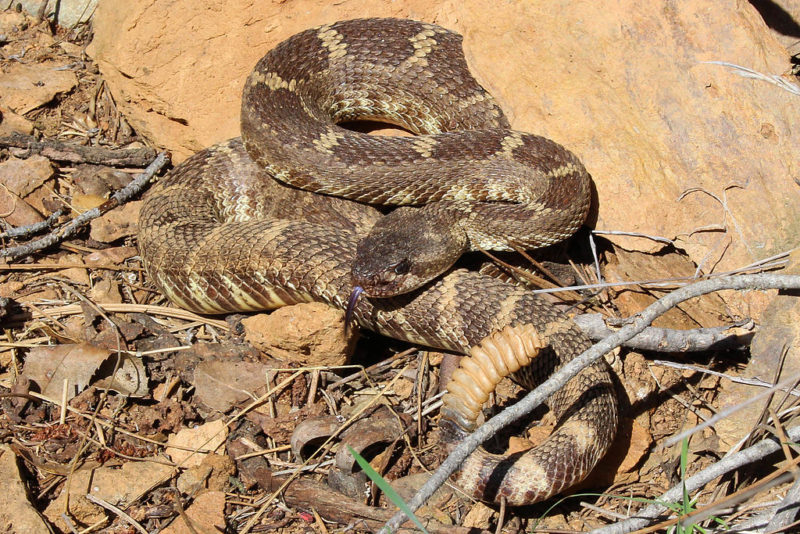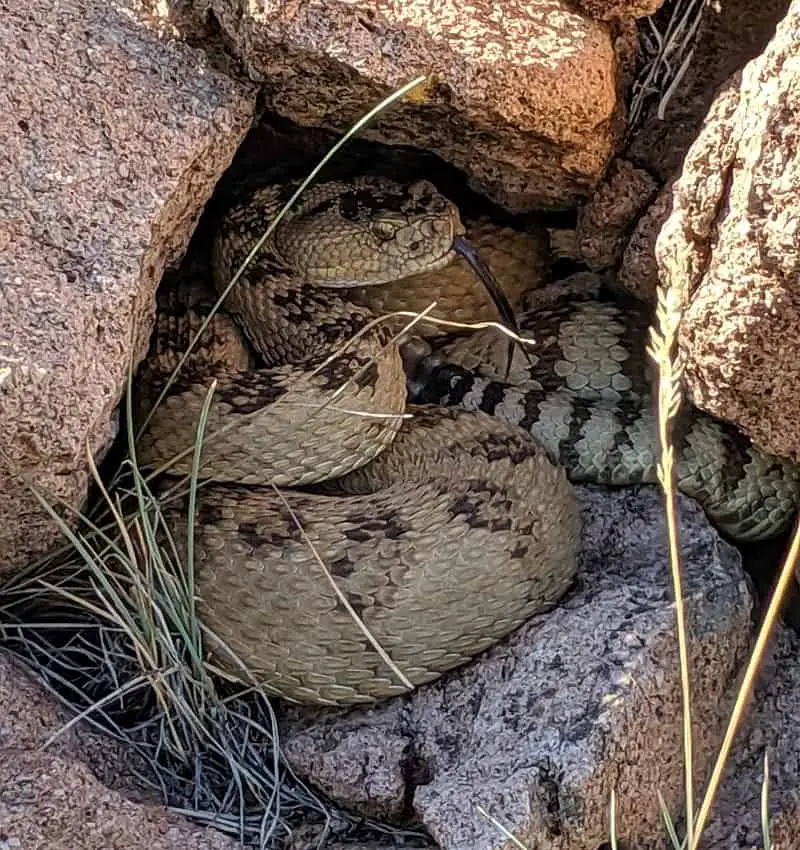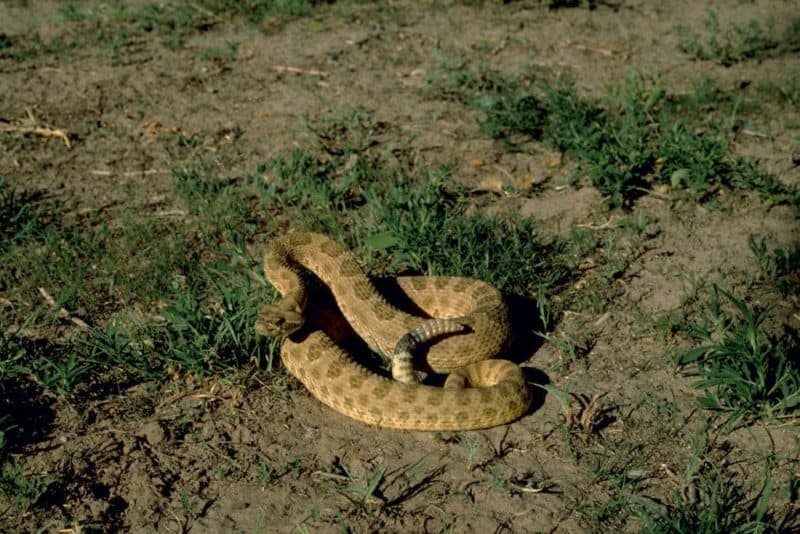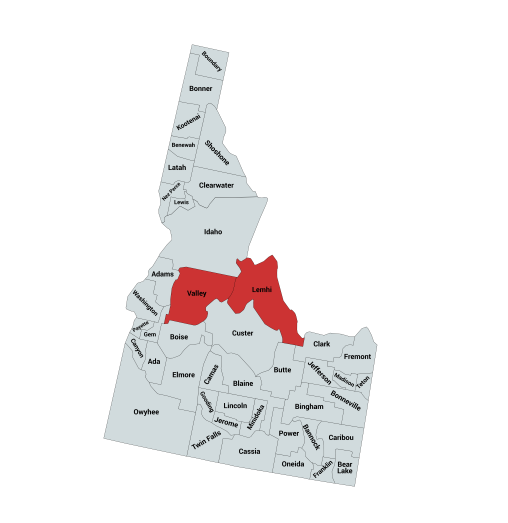All of the venomous snakes in Idaho are rattlesnakes.
Idaho is home to the Prairie Rattlesnake, the Northern Pacific Rattlesnake, and the Great Basin Rattlesnake. The Northern Pacific and Great Basin Rattlesnake are both Western Rattlesnake subspecies.
Each of Idaho’s venomous snakes is vital to the state’s ecology. However, they also pose a significant risk. In Idaho, around 10 people get bitten by venomous snakes in an average year. Knowing more about their appearance, behavior, and habitats will make you safer in the Gem State’s outdoors.
We’ll talk about each of these Idaho rattlesnakes in the paragraphs below. We’ll tell you what these snakes look like, how dangerous they are, and where they live in Idaho.
Pit Vipers: The Venomous Masters of Infrared Detection
Rattlesnakes, Copperheads, and Cottonmouths are among the most well-known members of the venomous Crotalinae subfamily, also referred to as pit vipers. Since Idaho’s venomous snakes are all rattlesnakes, lets learn about pit vipers.
What Makes Pit Vipers Unique?
- Infrared-Sensing Pits:
A defining feature of pit vipers is the deep facial pit between their nostril and the eye on each side of their head. These specialized infrared-detecting organs allow pit vipers to sense heat emitted by prey. This adaptation enables them to:- Detect body heat from up to 1 meter away.
- Strike prey with pinpoint accuracy, even in complete darkness.
- Triangular Heads and Vertical Pupils:
- Head Shape: Pit vipers are recognized by their distinct triangular-shaped heads, which house their venom glands.
- Eyes: They have vertical elliptical-shaped pupils.
- Venomous Fangs:
Pit vipers have hollow fangs connected to venom glands. These fangs fold back against the roof of their mouth when not in use. All pit vipers are born with multiple fangs and replace them every couple of months. Old fangs are shed one at a time. Consequently, a pit viper bite may only involve one fang. - Pit Viper Bites: Interestingly, these snakes have a sphincter on each venom gland. This allows them to control the flow of venom through the fangs. A snake may elect not to inject any venom with a bite. Scientists surmise that this is because it takes time for it to rebuild its venom store. Twenty to twenty-five percent of pit viper-to-human bites are dry bites.
Ecological Importance
Pit vipers play a crucial role in maintaining ecosystem balance by controlling rodent populations. Despite their fearsome reputation, these snakes are vital to the health of many habitats.
Rattlesnakes
- What Idaho’s rattlesnake species have in common with most other rattlesnakes is their rattle.
- Most rattlesnakes have a rattle at their tail’s end, comprised of hollow, loosely interlocked keratinous scales.
- Normally, a rattlesnake adds a new segment to its rattle each time it sheds its skin.
- An agitated rattlesnake rapidly vibrates its tail, causing the segments of its rattle to vibrate together, creating a buzzing or rattling sound.
- If you hear a rattling noise, when you’re out in rattlesnake habitat do not move until you spot where it originated. Otherwise, you may accidentally move into the snake, provoking it to strike you.
- You must be aware of where you are placing your hands and feet in rattlesnake country.
- Not all of Idaho’s rattlesnakes rattle before they strike. Sometimes, they lose their rattles due to injury, and sometimes, they choose not to rattle.

Northern Pacific Rattlesnake (Crotalus oreganus)
Another name for the Northern Pacific rattlesnake is the Western rattlesnake.
What Do Northern Pacific Rattlesnakes Look Like?
| Size | *Average adult snakes can grow to 39 inches (99cm) long. *The longest Northern Pacific rattlesnake on record is 64 inches (163cm). |
| Coloration | *Base colors: Dark brown, dark gray, or black. *Back: A covering of dark blotches with lighter edges runs along their backs. *Tail: Lighter-edged blotches turn into crossbands at the tail. The last two crossbands at the end of their tail are generally black. *Belly: Pale yellow with brown spots. |
| Face | *A dark brown stripe runs from behind each eye toward the mouth. *The dark brown stripe is outlined with lighter stripes on either side. |
Where Do Northern Pacific Rattlesnakes Live in Idaho?

The Northern Pacific Rattlesnake is found in west-central Idaho along the Clearwater, Salmon, and Snake River drainages. They’re the only rattlesnakes in the Treasure Valley and the Boise foothills. Watch for these snakes in dry, rocky areas.
Gopher snakes inhabit a lot of the same territory that rattlesnakes do. Their territory includes the Boise Foothills. They are marked similarly to rattlesnakes and do a pretty good job of mimicking them. When gopher snakes are defensive, they sometimes vibrate their tails like rattlesnakes do. They also flatten out their heads to imitate the triangular head of a rattlesnake.
How Dangerous Are Northern Pacific Rattlesnakes?
Northern Pacific rattlesnake venom has neurotoxic properties, along with hemotoxins and myotoxins.
Envenomation from one of these snakes may cause a multitude of symptoms. These include pain, swelling, fatigue, muscle weakness, body aches, and joint pain. In some cases, enlarged lymph nodes, anxiety, drowsiness, nausea, and diarrhea occur. Some of the systemic symptoms include neurological symptoms, internal hemorrhaging, and kidney failure.

Great Basin Rattlesnake (Crotalus oreganus lutosus)
The Great Basin Rattlesnake is a subspecies of the western rattlesnake.
What Do Great Basin Rattlesnakes Look Like?
| Size | *Most Great Basin rattlesnakes are under 3 feet (0.91 m) in length. *The largest specimens can reach up to 4 feet (1.22 m). |
| Coloration | *Their bodies are light gray or light brown. |
| Dorsal Spots | *Dark blotches cover their bodies, typically dark brown to black with pale centers. |
Where Do Great Basin Rattlesnakes Live in Idaho?

The Great Basin Rattlesnake inhabits parts of southern Idaho below 44° N latitude. For reference, Saint Anthony is just under 44° north latitude in eastern Idaho. On the other hand, in western Idaho, Payette is just over 44° north latitude.
Great Basin Rattlesnakes live in the dry, barren landscape of the Great Basin. They can be in mountainous areas up to 11,000 feet above sea level. However, they’re most common below 8,000 feet. They live in a variety of habitats. These include juniper forests, sagebrush flats, and dry rocky hillsides.
How Dangerous Are Great Basin Rattlesnakes?
The Great Basin rattlesnake has a potent venom. It is a potent mix of myotoxins and hemotoxins. Their bites may produce pain, edema, nausea, and vomiting. Furthermore, the hemotoxic part of their venom can cause internal bleeding. This may lead to multiple organ damage. Moreover, the myotoxic part of their venom will produce necrosis of body tissue.

Prairie Rattlesnake (Crotalus viridis)
What Do Prairie Rattlesnakes Look Like?
| Size | *Adults typically measure about 3.3 feet (100 cm) in length. *The longest recorded specimen was just under 5 feet (151.5 cm) long. |
| Coloration | *Their base color varies and can be tan, olive green, or brown. |
| Dorsal Spots | *Brown blotches with darker borders are present on their bodies. |
| Head | *They have a triangular-shaped head with pit sensory organs on either side. *A light stripe runs diagonally from the back of each eye to the jaw. *Another stripe extends diagonally from below the eye to the corner of the mouth |
| Behavior | *Primarily ground-dwelling but occasionally climbs shrubs, bushes, or trees. |
Where Do Prairie Rattlesnakes Live in Idaho?

The Prairie Rattlesnake is found in Lemhi and Valley counties. These are in east-central Idaho. They also live in northeastern Idaho, along the Montana border. The Frank Church Wilderness Area rattlesnakes are prairie rattlesnakes. This is according to the Idaho Department of Fish and Wildlife.
Prairie rattlesnakes live in open prairies, arid grasslands, and mountainous terrain.
How Dangerous Are Prairie Rattlesnakes?
Prairie rattlesnake venom is a mix of hemotoxins and myotoxins. Furthermore, according to some literature, it also has neurotoxins.
Prairie rattlesnake bites can have serious effects. The venom can cause severe pain. It may also induce shock, making the victim feel weak and disoriented. Swelling, blistering, and inflammation can occur at the bite site. Their venom can also damage red blood cells and impair blood clotting. In severe cases, the bite may result in severe tissue damage. There is also a risk of harm to internal organs.
Avoiding Snake Bite in Idaho
Many bites happen when someone accidentally steps on or near the snake. With rattlesnakes, you might hear a rattle that tells you that you’re getting too close but then again you might not. To stay safe in snake habitats, always watch where you step and where you place your hands.
Another common cause of snake bite is attempts to capture or kill a snake. Remember, venomous snakes can strike instantly, delivering a potentially life-threatening bite. The safest approach is to keep a safe distance and leave them alone.
Dressing for Snake Country
- High-top leather boots and long pants are both wise ideas.
- Also, wear loose-fitting denim. If there’s a gap before the snake’s fangs touch your skin, your chances of being envenomated are lower.
- In the absence of high-top leather boots, some people wear snake gaiters.
Symptoms of Venomous Snake Bites
Some of the symptoms you may experience from a venomous snake bite include:
- Discoloration in the area of the bite.
- Swelling in the area of the bite.
- Loss of muscle coordination.
- Tingling sensation in the area of the bite.
- Feeling nauseous.
- Having an abnormally rapid pulse.
What Should You Do If A Venomous Snake Bites You?
If you or someone you are with has suffered a venomous snakebite, time is of the essence. The sooner a victim receives antivenom, the less likely the venom in their body is to cause harm. In other words, it is important to seek immediate medical attention.
Do not attempt to kill the snake for identification purposes. This gives the snake a chance to bite you again. Also, consider that severed snakeheads can still bite and envenomate. If you have a phone, take a picture of the offending reptile. Otherwise, get started on your way to the nearest hospital.
First Aid for Snake Bite Victims
- Remain calm and limit your movements. Do not run. If you must hike back to a vehicle, do it calmly and deliberately. Put as little stress on your heart as possible.
- Keep the area of the snake bite below the heart level and never above the heart level. Keeping the bite below the heart level will reduce the venom’s flow. However, holding the bite above your heart level will increase the venom’s flow.
- Remove all constricting items such as bracelets, watches, or rings before swelling occurs.
- Remember that using a cold compress on a venomous snake bite is not advisable. The cold may cause the local blood vessels to constrict and spread the venom faster.
- You can wash the affected area like any other wound with soap and water.
- You may cover the bite area with a moist dressing to reduce the swelling.
- Get medical attention as soon as possible. Call the hospital to tell them a venomous snake has bitten you so they can have antivenom ready to give you when you arrive.
- A person whom a venomous snake has bitten may go into shock. If this happens, lay them flat and cover them with a blanket.
Antivenom Price For Treatment of Snake Bite in Idaho
To manufacture antivenom, they must first milk venom from a live snake. Then, they inject that venom into donor animals like horses or sheep. Next, they harvest the antibodies that these animals produce. That’s a simplified version of the complicated process involved in manufacturing antivenom.
Antivenom is expensive to produce. But, it’s a vital life-saving therapy for some individuals who have been bitten by venomous snakes.
The two main antivenom therapies that cover pit viper venoms in the U.S. are CroFab and Anavip.
When a patient undergoes antivenom therapy, the doctor administers a minimum starting dose. More vials of antivenom will be added depending on the severity of envenomation.
The average cost of crotalidae polyvalent immune fab ovine or CroFab is $3,198 per vial. The recommended starting dose is 4 to 6 vials.
The average cost of Crotalidae immune F(ab’)2 (equine) or Anavip is $1,220 per vial. The recommended starting dose is 10 vials.
The type of antivenom in use varies between different healthcare providers. Also, note that the prices listed above do not reflect the total cost of the treatment. They are the average wholesale price for vials of snake antivenom. In other words, they are what healthcare providers pay.
Conclusion
Idaho is home to three dangerously venomous snakes: the Northern Pacific Rattlesnake, the Great Basin Rattlesnake, and the Prairie Rattlesnake. While these fascinating reptiles help maintain ecological balance by controlling rodent populations, they can pose risks to humans. Understanding their habitats, identifying their unique characteristics, and knowing how to respond in case of a snakebite are essential for safely coexisting with these creatures.
When exploring Idaho’s outdoors, always exercise caution when in rattlesnake country. Be mindful of where you step or place your hands. Also, wear clothing and footwear that will give you some snakebite protection. Finally, if you hear that tell-tale buzzing sound, remain still until you locate the snake, then give it plenty of space. If bitten, remain calm, seek immediate medical attention, and follow proper first-aid protocols. By respecting the natural habitats of these rattlesnakes and taking necessary precautions, you can enjoy Idaho’s outdoors safely while appreciating the important role these snakes play in the ecosystem.
For more tips on snake safety and identifying Idaho’s venomous snakes, bookmark this guide and stay informed!
Scorpions in Idaho – Krebs Creek
Wild Cats in Idaho – Krebs Creek
Recent Posts
The only venomous snakes in Washington State are Northern Pacific Rattlesnakes. The Northern Pacific Rattlesnake (Crotalus oreganus oreganus) is a sub-species of the Western Rattlesnake. Anyone...
Skunks are not classified as true hibernators. But they go into a state of torpor when the weather gets cold. Skunks are light sleep hibernators, along with opossums, bears, and raccoons. ...
